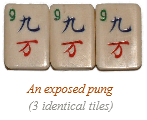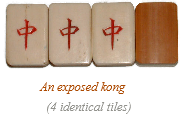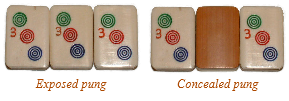.P
Playing aid
.
Starting the game
East Wind chooses one tile from his hand and discards it by placing it face-up inside the walls.
A discarded tile is dead (plays no further part in the game) unless it is claimed immediately.
Turns move in an anti-clockwise direction (to the right), so it’s normally South Wind’s turn next to obtain and discard a tile.
However, to appreciate what can happen next you need to understand what is involved in collecting sets, claiming a chow, pung or kong – and declaring Mah-Jong.
.
Collecting sets
You build up sets by obtaining and discarding one tile at a time. The discarded tile is placed face up inside the walls. You can, of course, discard the tile you’ve just acquired.
Types of sets
There are 3 types:
- Chow – a run of three tiles in the same suit
- Pung – a set of three identical tiles
- Kong – a set of four identical tile

Sets and “Mah-Jong”
The aim is to arrive at four sets, plus a pair of identical tiles – this is “Mah-Jong“.
There is no discard after the final tile is acquired to make a Mah-Jong.
Chows
A chow does not score, so it is only useful in that it may allow a player to call “Mah-Jong!”.
Only one chow is allowed in a hand (and none are allowed if you are playing the goulash or there are only three players).
.
Special hands
There are a number of special hands which, because they are unusual, score 500 or 1,000 points. 1,000 points is the maximum that can be scored in any one hand so, not surprisingly, a lot of luck is required to go out with such a hand.
Some of these special hands do not conform to the 4 sets and a pair described above but, nevertheless, allow you to declare Mah-Jong. Collecting such hands is risky because, if you are not successful, you could end up with a hand which is worth no points.
.
Obtaining a new tile
The most common way in which the game proceeds is by the player whose turn it is picking up a tile from the start of the live wall. It may be discarded or kept in hand and another discarded.
The player should describe the discarded tile, for example “Red Dragon”.
This routine is only interrupted when a player claims the discarded tile by a chow, pung or kong (or by going Mah-Jong).
.
Claiming the discarded tile
There are various ways of claiming the last discarded tile:
By calling “Chow!”
 Only the player whose turn it is may form a chow by using the last discarded tile. To do so the player must call “Chow!“, then lay the three tiles face up on the table in front of him and discard an unwanted tile. A player can only claim one chow in a session (and none when playing the goulash or when there a just three players).
Only the player whose turn it is may form a chow by using the last discarded tile. To do so the player must call “Chow!“, then lay the three tiles face up on the table in front of him and discard an unwanted tile. A player can only claim one chow in a session (and none when playing the goulash or when there a just three players).
By calling “Pung!”
 Anyone who can make a pung from the last discarded tile may do so by calling “Pung!“, laying the three tiles face up on the table then discarding an unwanted tile.
Anyone who can make a pung from the last discarded tile may do so by calling “Pung!“, laying the three tiles face up on the table then discarding an unwanted tile.
The turn then passes to the player on right of the one who has punged. So any intervening players miss a turn.
By calling “Kong!”
 Anyone who can make a kong from the last discarded tile may do so by calling “Kong!” then laying the tiles on the table (three face-up and an outer one face-down).
Anyone who can make a kong from the last discarded tile may do so by calling “Kong!” then laying the tiles on the table (three face-up and an outer one face-down).
Because an extra tile is required for a kong the player must now pick up a tile from the kong box and discard an unwanted one.
The turn then passes to the player on the right of the one who has konged and any intervening players miss a turn.
By calling “Mah-Jong!”
Anyone who can make Mah-Jong from the last discarded tile can do so to end the game.
(Of course, Mah-Jong may also come from someone picking a tile from the wall).
When there is contention
It is possible that more than one player may want to claim the same tile. The rules of precedence are as follows:
- A pung or kong takes precedence over a chow.
- Mah-Jong takes precedence over a chow, pung or kong.
- If more than one player can make Mah-Jong with the discarded tile, then the nearest player to the right of the discarder (i.e. going in an anti-clockwise direction) takes precedence.
.
 Flower and Season tiles
Flower and Season tiles
If you pick up a Flower or Season tile from the wall you should reveal it immediately and pick another tile from the kong box.
.
Concealed sets

Concealed sets are those that have not been obtained by claiming a chow, pung or kong. A concealed chow is not worth anything, but concealed pungs and kongs are worth twice their exposed counterparts.
If you make a concealed kong by picking up the fourth tile from the wall, then you would normally declare a kong, lay the four tiles in front of you and pick up a new tile from the kong box.
But this action is not compulsory as you may be looking to create a particular special hand.
.
Converting a pung to a kong
An exposed pung can be converted into an exposed kong, but only by using a tile taken from the wall. The player must then take another tile from the kong box.

.
One for Mah-Jong
When a player only requires one more tile to finish he must declare “One for Mah-Jong!” or “Fishing!“. This alerts the other players to be more careful with their discards. The player in question is said to be “calling“.
.
Robbing the kong
Where a player takes a tile from the wall and makes a kong from an exposed pung, another player can “rob the kong” in order to go Mah-Jong.
The only sets he can thereby make, however, is a chow or a special hand. In the case of the chow, it can be claimed even when the player is not immediately to the right of the discarder.
Robbing the kong for a chow gives the player a double, but having a chow in the hand also causes him to forfeit one. So the double is immediately lost.
Note that an already exposed kong cannot be robbed.
.
Finishing the game
The game is normally finished by someone declaring “Mah-Jong!“, usually by forming 4 sets and a pair. This always involves retaining the last tile claimed or picked up from the wall.
After Mah-Jong has been declared each player places his hand on the table. The tiles of exposed pungs are all set face-up.
A concealed pung has the middle tile turned face-down. An exposed kong has one of the end tiles turned face down, and a concealed one has the two end tiles turned face-down.


Scoring then begins. The winner is scored first and everyone pays him. The other players’ scores are then worked out and payment is made based on the difference between their scores.
Example of the end of a game
At the end of the game the tiles in each hand are laid out so that they can be scored.
In this example:
- East Wind has gone Mah-Jong
- South Wind is fishing – he’s one tile away from a special hand called The Wriggling Snake
Also see questions on Playing the game
.
.
.
.
.
.
.
.
.
.
.
.
.
.
.
.
.
.
.
.
.
.
.
.
.
.
.


